2023 MXA 125 TWO-STROKE SHOOTOUT: HUSQVARNA TC, GASGAS MC, YAMAHA YZ & KTM SX GO TO WAR
After Honda, Kawasaki and Suzuki canceled their two-strokes, the 125 class became a two-horse race between Yamaha and KTM. Not so long ago the idea of Yamaha making updates to its tried-and-true YZ125 seemed like a pipe dream. Most racers were content to see Yamaha simply press “copy/paste” on the YZ125, and they were happy to see KTM steadily improving bikes in a class with slim competition. Amazingly, our Yamaha pipe dreams came true when the blue crew handed us the most updated YZ125 since it got Kayaba SSS suspension back in 2006. It demonstrated a renewed commitment to two-strokes. One year later we’ve lined up the latest and greatest 125 two-strokes again, only this time there are a few differences. Out of the four bikes in this test, only two of them have kickstarters, and only two of them have carburetors.
FOR 2023 KTM AND HUSQVARNA TOOK A BIG LEAP INTO THE FUTURE WITH UPDATED TWO-STROKES THAT FEATURE ELECTRIC STARTING, ELECTRONIC FUEL INJECTION, ELECTRONIC POWER VALVES AND A NEXT-GEN FRAME.
KTM and Husqvarna took a big leap into the future with updated two-strokes that feature electric starting, electronic fuel injection, electronic power valves and a next-gen KTM and Husqvarna chassis that encompass new frames, swingarms, subframes and bodywork, all matching the orange and white four-strokes. In a controversial move, carburetors were axed, which means jets, needles and air screws will no longer need to be changed or adjusted on KTM and Husky two-strokes. The decision to switch over to EFI technology is welcomed by riders who aren’t savvy enough to jet their bikes but is frowned upon by riders who appreciate the simple, affordable and easy-to-maintain two-stroke technology that we all know and love.
Don’t get too worried, though, the new fuel-injected two-strokes aren’t Transfer Port Injected (TPI) like the previous “fuel-injected” off-road two-strokes from KTM and Husky. The new two-strokes gain an all-new 39mm Keihin Throttle Body Injection (TBI) system that uses a throttle position sensor (TPS) and dual injectors to create the proper fuel/air mixture. The TPI-equipped off-road two-strokes of the past few years weren’t confidence inspiring as the engineers worked through the teething issues that always come when you are the first to try something new. To its credit, KTM said, “Out with the old and in with the new.” Additionally, the TPI bikes were oil-injected, so the oil and fuel were mixed for you on the bike. The TBI version of KTM’s fuel-injection is back to the same old 40:1 pre-mix ratio that we know and love. Plus, the new KTM/Husky engines use a gear-driven electronic power valve, creating the opportunity for two different maps that can easily be switched on the track.
WITH KTM AND HUSQVARNA INTRODUCING ALL-NEW BIKES, THE GASGAS IS STILL CARBURETED AND KICKSTART. THE GASGAS IS THE STAND-ALONE AUSTRIAN MODEL THAT SHOULD PROVIDE A SAFE HAVEN FOR HARDCORE 125 RIDERS.
With KTM and Husqvarna introducing all-new bikes, the GasGas is now uniquely different from its siblings. The GasGas MC125 is still carbureted and kickstart. KTM now only has two 125 two-strokes that platform share most of the same running gear, while the GasGas is the stand-alone Austrian model that should provide a safe haven for hardcore 125 riders who don’t want modern accouterments.
Yamaha subjected its YZ125 (and YZ250F) to a year of rest without any changes as they focused all their attention on the new YZ450F in 2023; however, this isn’t the same YZ125 that’s been around since 2006. Yamaha made big changes in 2022. The cylinder body, cylinder head, cylinder port shape, cylinder port timing, piston, piston pin, connecting rod, crankcase, crankshaft, flywheel, transmission, shift shaft, reed valve and power valve, as well as the pipe and silencer, all received updates. The new bodywork and subframe also helped contribute to more power with increased air flow through the intake and airbox.
MXA spent a lot of time on the four 125cc two-strokes in this shootout. As always, we raced them, dynoed them, weighed them and lived with them. Read on to discover what we thought of them.
2023 HUSQVARNA TC125
The new Husqvarna comes into the lineup with the same frame, engine and swingarm as the KTM 125SX—only with the proprietary lowered suspension concept that was introduced in 2021 and a different subframe that is completely closed off underneath the seat. Strangely enough, this is the same airbox that’s wide open on the KTM 125SX. The WP XACT air forks are 10mm shorter on the Husky, and the shock’s seal head is longer on the shock to limit its stroke (to keep the rear tire from hitting the fender). The shock linkage has a revised ratio to drop the seat down about an inch while attempting to retain a similar suspension feel to the KTM.
On the track, the Husqvarna TC125 is easier to corner and easier to find traction with in the slick stuff. With the bike being lower to the ground, it’s nimbler. Plus, although Husqvarna and WP have tried to mimic the feel of the 125SX suspension, the shortened fork cartridge rods, lowered shock and different linkage create a suspension setting that feels softer than the KTM’s.
As for the power, many of the sensations from the KTM transfer over. The horsepower and torque are practically identical on the dyno, but on the track, they feel different due to the closed-off air box. The KTM picks up quicker on corner exit, while the Husky is slightly more casual. To give it more snap, we added the vented air box cover that comes with the bike.
One big downfall for both the KTM and Husqvarna in 2023 is the added weight. The new 2023 four-strokes gained 5 pounds via their updated chassis and bodywork, while the new KTM 125SX gained 10.5 pounds and the Husky TC125 gained 9.5 pounds.
How did this happen? Well, the Austrians added a lot of tech for 2023. Because of the fuel-injection system, gone is the carburetor with its simple petcock draining fuel out of the tank. Now, each fuel tank needs a fuel pump. Plus, the KTM and Husky each gained a battery and electric starter motors, which is silly since 125 two-strokes are so easy to start anyway. They also gained an electric motor, replacing a spring, to operate the power valve. Plus, the stiffer 2023 chromoly steel frame and new bodywork are stronger and heavier. All in all, the Austrian bikes gained an extra 5 pounds on the scale (except for the red ones). Although 204.5 pounds is still light compared to four-strokes, it’s heavy compared to the 194-pound GasGas and 199-pound Yamaha. We hate that they added weight, because now the 1-horsepower difference between the GasGas and KTM/Husky on the dyno is actually more like a 2-horsepower difference on the track.
2023 KTM 125SX
We were able to get our hands on the 2023 GasGas and Yamaha 125s fairly early in the year, but we had to wait patiently for the new Austrian bikes. The new electronic fuel-injected engine created a pleasant roll-on power that made it easier to get on the throttle smoothly, without hesitation and with less clutch action required. It was a unique sensation to ride a 125SX with a gentle and smooth roll-on style of power instead of the traditional, crisp snap that 125s are known for. In the past, the KTM 125 was known for its more advanced style of power that required skill to use properly, while the Yamaha YZ125 was known for its friendly power off the bottom end, which made the bike easier to ride for everyone and was especially appreciated by less experienced two-stroke riders. For 2023, the KTM’s combination of fuel-injection and an electronic power valve for the KTM 125SX is helpful off the bottom.
Through the midrange, the 125SX felt fast, and it pulled hard on top, too; however, right away our testers were caught off guard by the odd noises coming from the silencer when the engine was revved out. What was it? It turns out that the new engine has a rev limiter that pops and stops the rpm from continuing to climb. It took some time to get used to, but we learned that you had to be extra quick with your left foot on the 125SX because it didn’t like to be revved to the moon.
With the new chassis, we expected the break-in period to be extensive—like it was on the 2023 450SXF, but we were met with compliance and comfort much earlier on. Although it’s been said that KTM uses the same frame for all of its big bikes, two-stroke and four-stroke, we found out that KTM actually uses smaller, different frame cradles on the two-strokes to accommodate the smaller engine. Still, the rest of the frame is the same, from the forged gusseting on the front of the frame to the rest of the frame’s geometry. So why didn’t the 125 require 10 hours of break in? Well, compared to the 450SXF engine, the 125SX engine is lighter and slower, and the suspension is valved to be much softer. Plus, the 125SX doesn’t have engine braking. Truthfully, all the 2023 models from KTM and Husky are easier to break in than the 450, and it seems that the smaller the engine, the less time it takes to break in the chassis.
2023 GASGAS MC125
As test riders, we love that the KTM Group bought GasGas, because it brought another brand into the motocross market. GasGas wasn’t focused on motocross before. Yet, we also understand why riders are frustrated that it has just been “a red KTM” up to this point. For riders who complain that KTM is flooding the tracks with more KTMs and less diversity, you’re wrong. KTM sold the tooling used in the previous GasGas dirt bike operations to Reiju, who is selling the previous GasGas bikes as rebranded Reijus. Thus, if you think KTM killed a brand by buying GasGas, they actually saved one brand and added another one.
What the KTM Group did for 2023 was pure genius. While they updated the KTM and Husky bikes with all-new chassis and engines, they left the GasGas and its trusted chassis and engine alone for one more season. Dealerships have sold more GasGas models in 2023 than in the past two years since KTM bought the brand.
For the GasGas MC125, the proven 125 engine, Keihin carburetor and chromoly steel frame remain the same, which is very appealing to riders scared of first-year models. The 2023 GasGas MC125 may not be platform-shared with its brothers for 2023, but it uses the same engine, throttle body, carburetor, frame, swingarm and subframe as the 2022 KTM 125SX, only with forged aluminum triple clamps instead of CNC-machined clamps, softer WP suspension valving, Maxxis tires instead of Dunlop, and a closed-off airbox cover that can easily be turned into a KTM airbox cover with some do-it-yourself modifications.
Because this bike remained the same, the testing process was simple; however, it was very nice to have this bike to compare back and forth with the next-gen fuel-injected engines and the tried-and-true Yamaha. Compared to the KTM and Husky, the GasGas revs to the moon. Even with the closed-off airbox cover, our testers got up to speed quicker and pulled each gear longer on the GasGas than the KTM, Husky and Yamaha. The one area where the MC125 suffered was at the crack of the throttle. In its stock form, this bike was the least willing to jump into the meat of the powerband at low rpm; however, it’s easily helped by drilling a few holes and trimming the lip off the back of the airbox cover.
2023 YAMAHA YZ125
The Yamaha YZ125 stayed the same for so long (2006–2021) that we gave up on asking for updates and shifted our mindset to being content that Yamaha was still willing to make two-strokes. After all, it wasn’t such a bad gig. The YZ125 has consistently been “the most fun bike to ride” in the MXA stables; however, when Yamaha announced its all-new engine for 2022, we got greedy and expected a full-race 125 that would take down KTM. Unfortunately, the dyno showed that Yamaha’s new engine was only 1 horsepower stronger than before in the midrange, and it revealed that the new Yamaha engine was actually slower off the crack of the throttle all the way up to 7500 rpm than the previous YZ125 engine, which ran for over a decade.
To help the YZ125 get up to speed quicker, we added a tooth to the rear sprocket, going from a 13/48 to a 13/49 sprocket combination. Yamaha also increased the Kayaba spring rates last year, going from 4.2 to 4.3 in the forks and 46 to 48 on the shock. The valving has been made stiffer, too. Plus, the new subframe and seat from last year created a flatter topography of the bike with a taller seat height. The stiffer suspension and new bodywork made the YZ125 feel racier; however, our faster and heavier test riders still complained that the suspension was too soft.
On the track, the YZ125 is still a blast to ride. Although it’s not quite as easy to exit corners as it was before, the YZ125 still gets up and goes. It requires less clutch to light up the rear wheel than the GasGas 125. Our test riders had fun on the YZ, and many of them thought they were faster and more competitive on this bike, until they started actually racing and/or noting lap times. In terms of the fun factor, the YZ125 is a 10, but when the gate drops, the power difference is really clear. If you were racing against a class of YZ125 riders only, you’d be in heaven, but there’s only one race we know of where that is the case, and it’s the “bLU cRU YZ125 Cup” in Europe.
MXA 125 BIKE OF THE YEAR — AND THE WINNER ISN’T WHO YOU THINK IT IS
The rankings of our “125 Shootout” lean hard on engine usability and power delivery. At slower speeds, it’s easier to dodge bumps and pick smooth lines. With a lighter weight, a bike handles better over the bumps, stops easier and is nimbler. With less rotating mass, a bike leans over in corners, also contributing to a nimbler feeling. If your 125 handles well, that’s nice. If it handles poorly, then you got a lemon. But how does it run?
FIRST PLACE: 2023 GASGAS MC125
In its third year under the KTM banner, GasGas has won its first-ever MXA shootout! Who knew a bike could advance to the top spot in a shootout without making a single change? The “keep it simple, stupid” approach won this year. With a 1-horsepower advantage over the updated KTM and Husky models and a 2.5-horsepower advantage over the Yamaha, the GasGas MC125 made it easier to get on the pipe out of corners, and the Keihin carburetor allowed our testers to over-rev the two-stroke engine far past the limiter that’s set on the 2023 KTM and Husky two-strokes.
SECOND PLACE: 2023 KTM 125SX
Our initial impressions of the 125SX led us to believe this bike would easily claim the win. It’s smooth to roll into the power, making it easier to ride, yet it still has a solid top-end pull; however, we did have some mapping issues with the 125SX. With Pro-level riders at the helm, using 91-octane pump fuel mixed at a 40:1 ratio, we were able to get the 125SX to detonate in Map 1. We fixed the pinging with VP C12 and eventually went back to pump fuel. We didn’t have issues again, but we have to warn you that it can happen. Then, we found a random bog in map 2 (the green map), which was almost impossible to replicate when we wanted to. Both issues caused some head scratching, and KTM didn’t have any fixes for us. As always, first-year models are subject to bugs, and KTM certainly has some debugging to do with its EFI two-strokes.
THIRD PLACE: HUSQVARNA TC125
The Husky TC125 slides into third place. We’re happy that the KTM and Husky 125s have different subframes, creating a slight distinction between each bike’s power characteristics; however, it’s bad news for Husky that the molded plastic subframe can’t be replaced or modified as easily as a plastic airbox cover. The lower suspension platform was better for Novices and shorter riders because it felt softer. Some Novices who usually stay away from ruts were much happier to navigate them on the TC125 than any other bike because the lowered suspension inspired confidence; however, for our faster riders, the TC was too soft.
FOURTH PLACE: YAMAHA YZ125
We hate to keep putting the Yamaha YZ125 in fourth place, because every test rider has a soft spot for this bike. But, it’s not fast enough to keep up with the Austrian trio. Yes, you can spend money to beef up the engine, but the KTM, Husky and GasGas riders can easily do the same to stay ahead. This bike is extremely fun to ride, but if you’re competitive, you wouldn’t want to race the stock YZ125 against a stock 125SX, MC125 or TC125.
2023 125 HORSEPOWER & TORQUE CHART BY BRAND & RPM
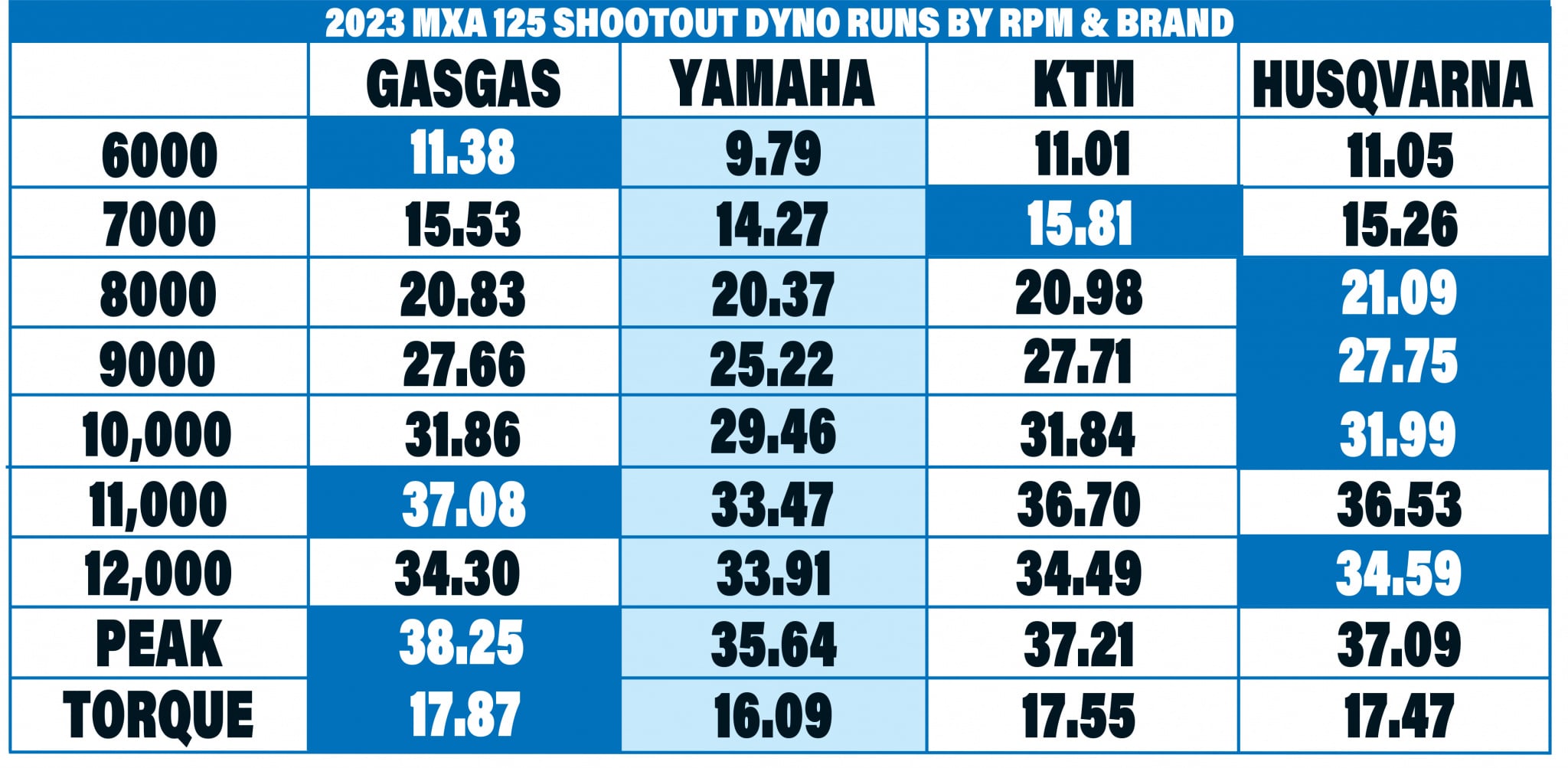 There are nine categories that cover horsepower by brand at 6000 rpm all the way to 12,000 rpm, plus peak horsepower and torque. The blue boxes signify the bikes that are the best in that rpm range. The light blue boxes show the bikes that are the worst in each category.
There are nine categories that cover horsepower by brand at 6000 rpm all the way to 12,000 rpm, plus peak horsepower and torque. The blue boxes signify the bikes that are the best in that rpm range. The light blue boxes show the bikes that are the worst in each category.
2023 125 WEIGHT CHART
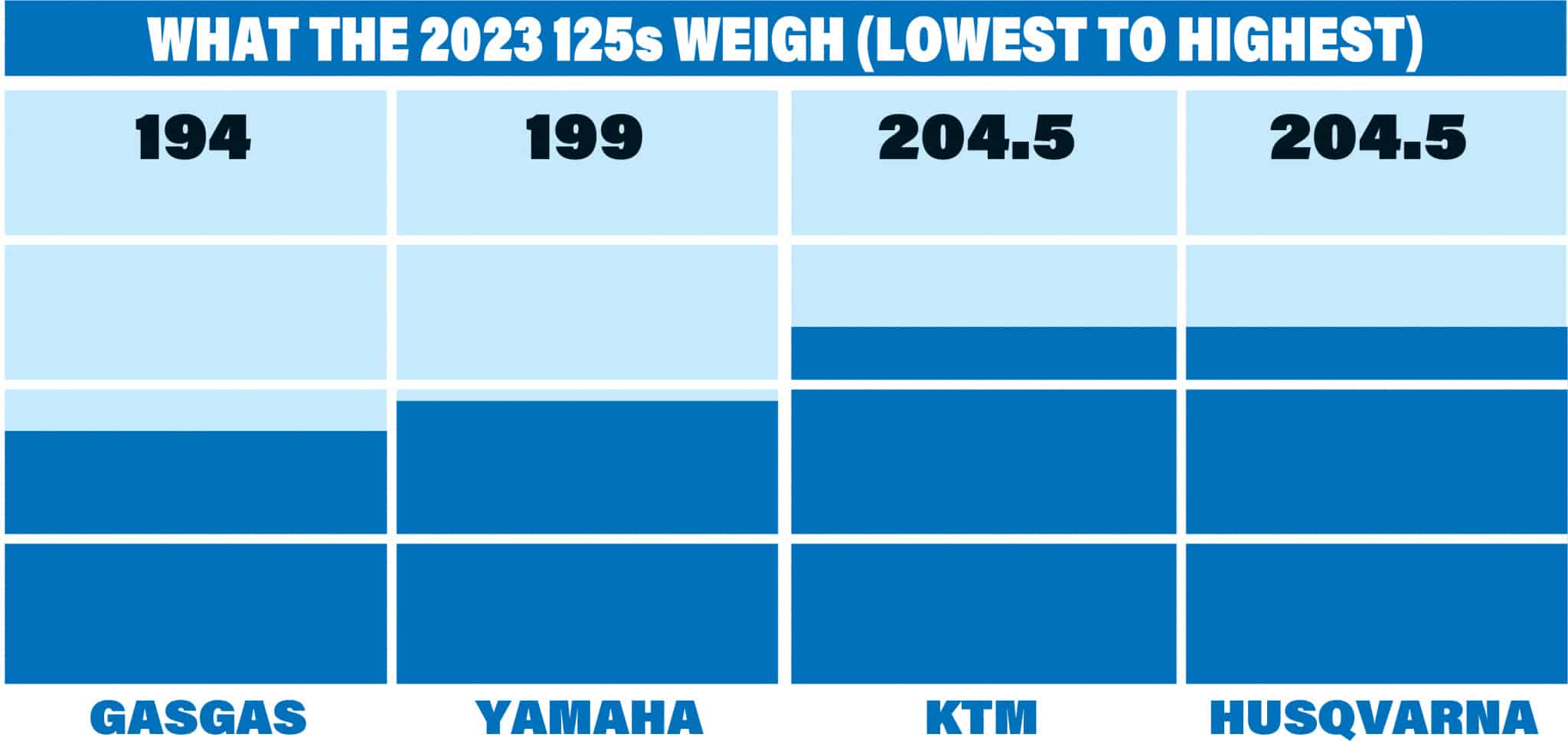
These are the actual weights of the current crop of 2023 125 motocross bikes (lightest to heaviest). They have been weighed on the same calibrated balance-beam scale under the official AMA and FIM system of empty gas tanks but all other fluids.
2023 125 MANUFACTURERS SUGGESTED RETAIL PRICE CHART

These are the manufacturers’ suggested retail prices (MSRPs) for all four 2023 125s (least to most expensive). Your local dealer is free to lower or raise the price of the bikes on their showroom floor. The price in the USA is determined by the exchange rate of the euro for European bikes and the yen for Japanese bikes.
2023 125 PEAK HORSEPOWER & TORQUE BY RPM CHART
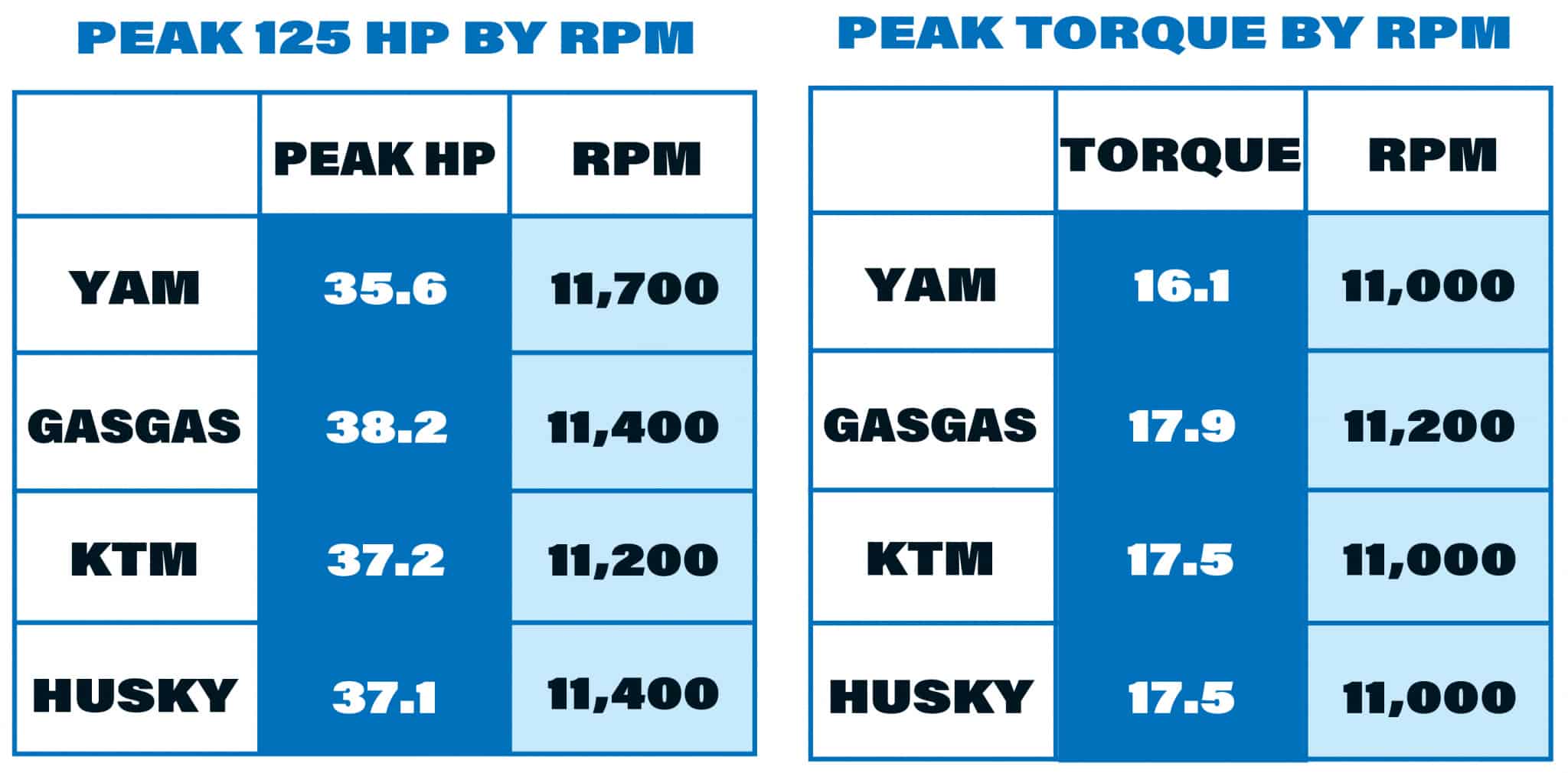
Peak horsepower isn’t all that important in the 450 class, but it’s of higher value in the 250 four-stroke and 125 two-stroke ranks. All the 125s handle well, but if your bike is slow, you’ll be left behind. Here is how the 125cc two-strokes stack up against each other.


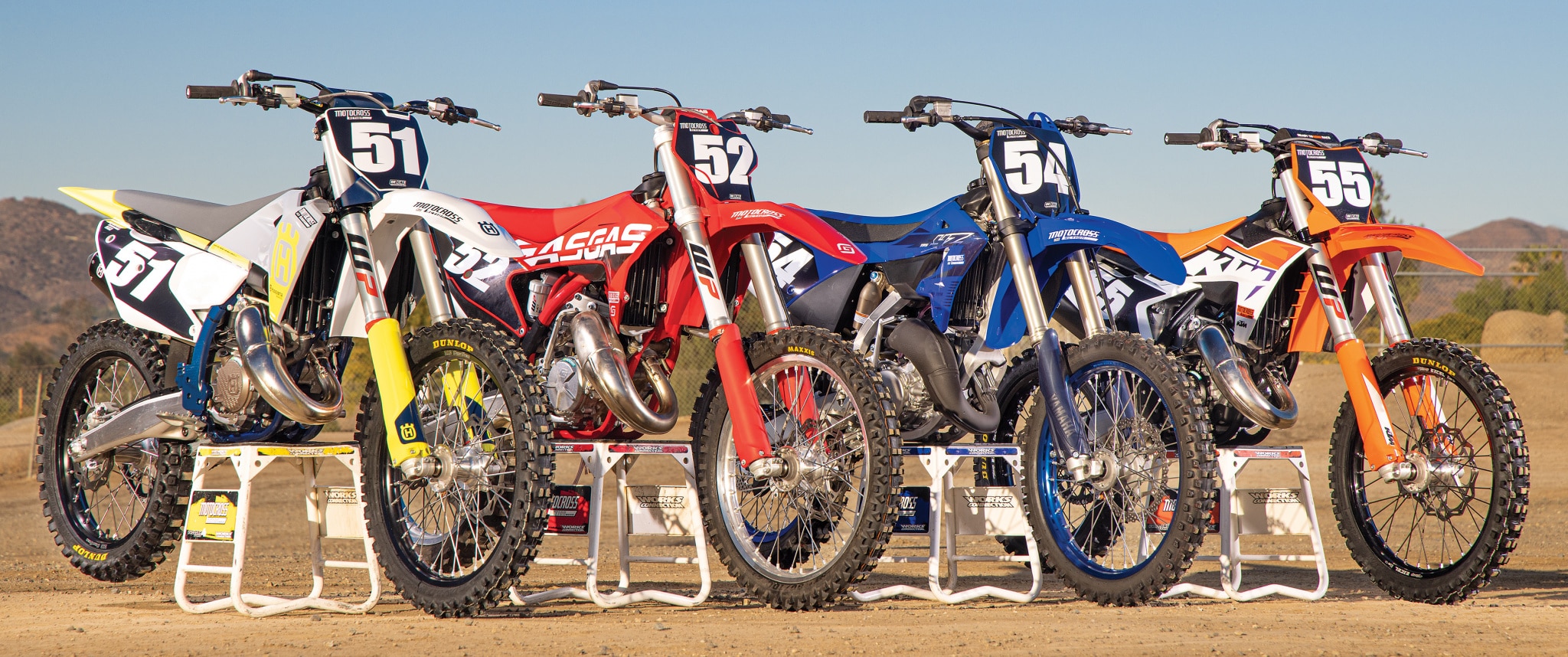
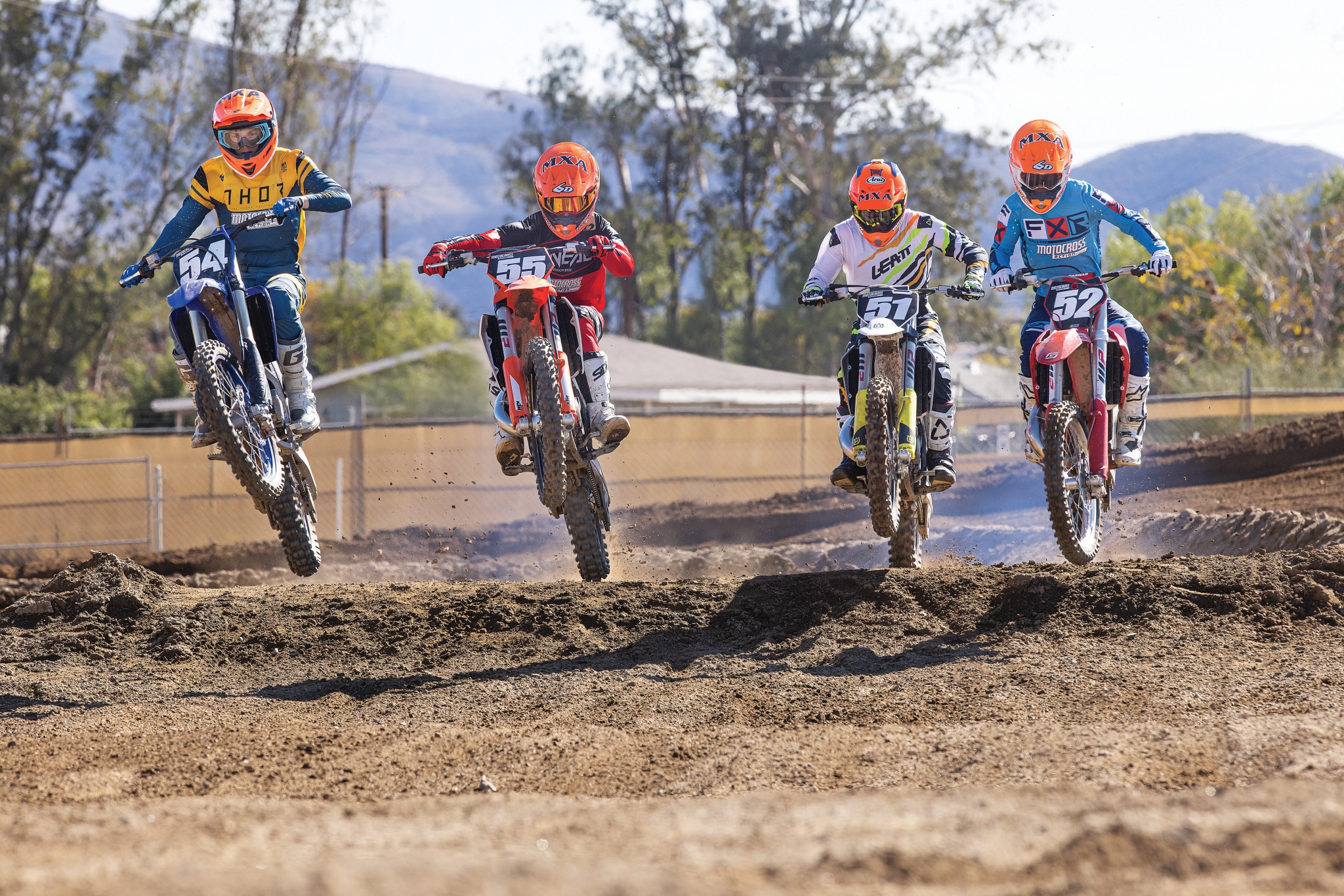
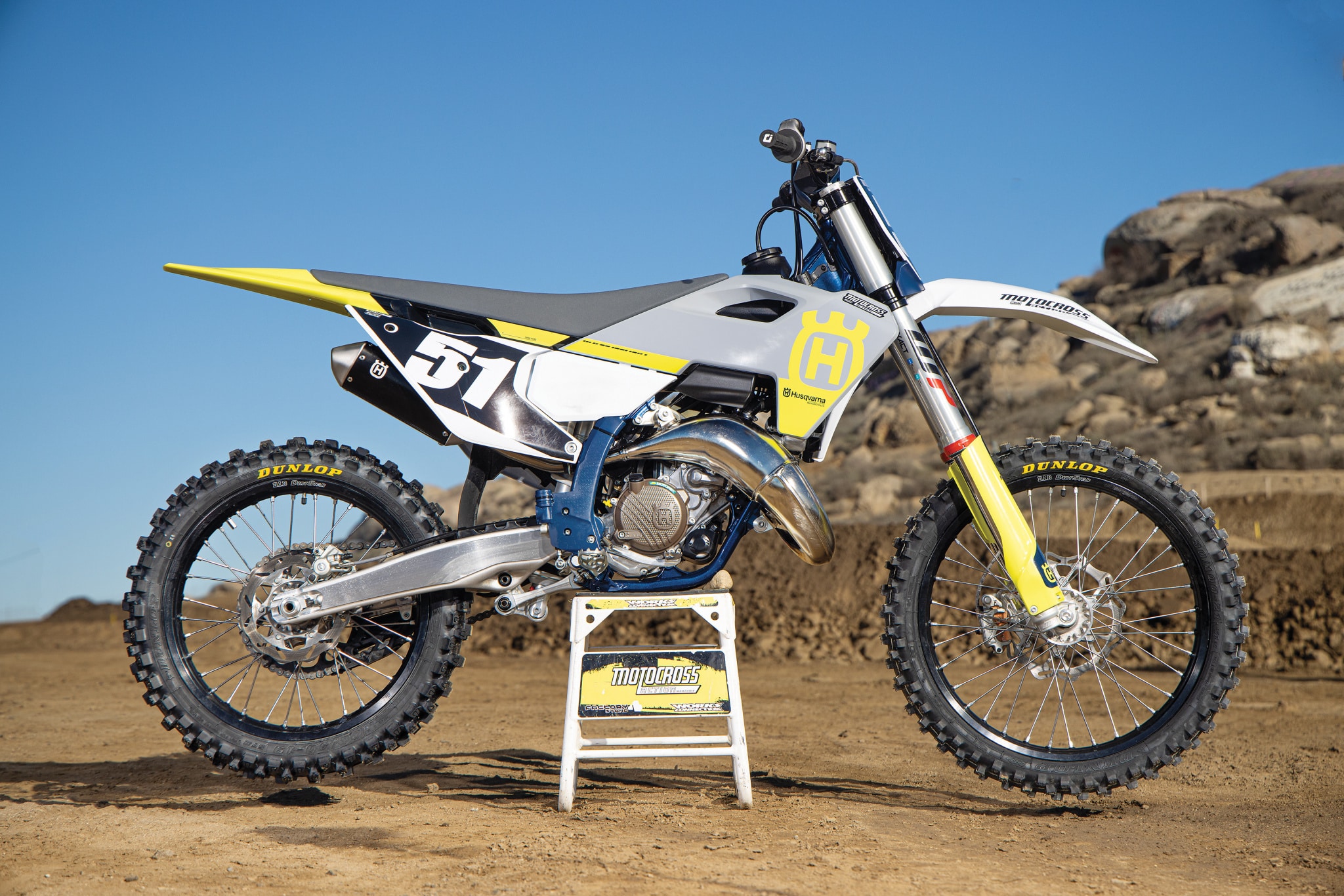
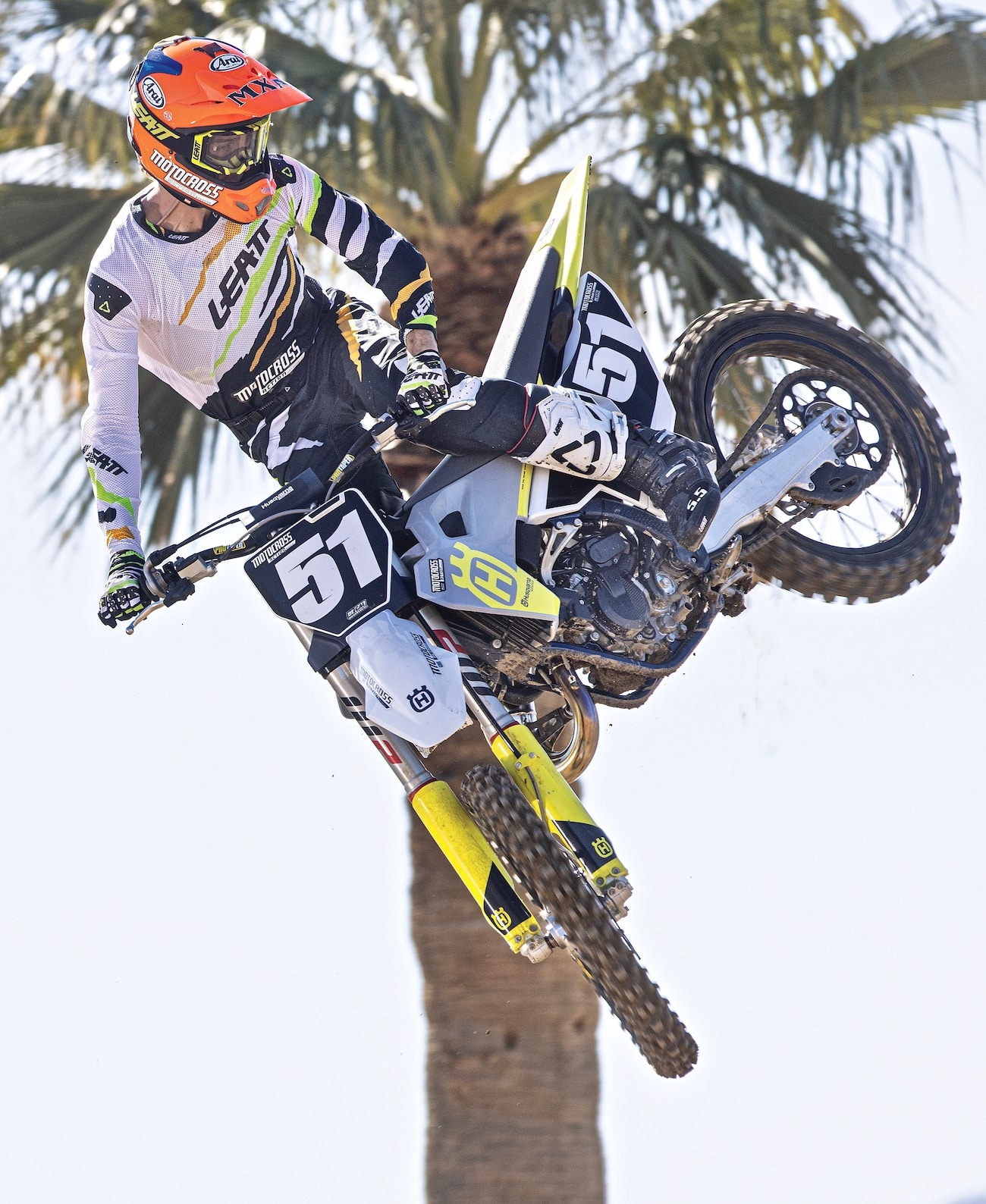
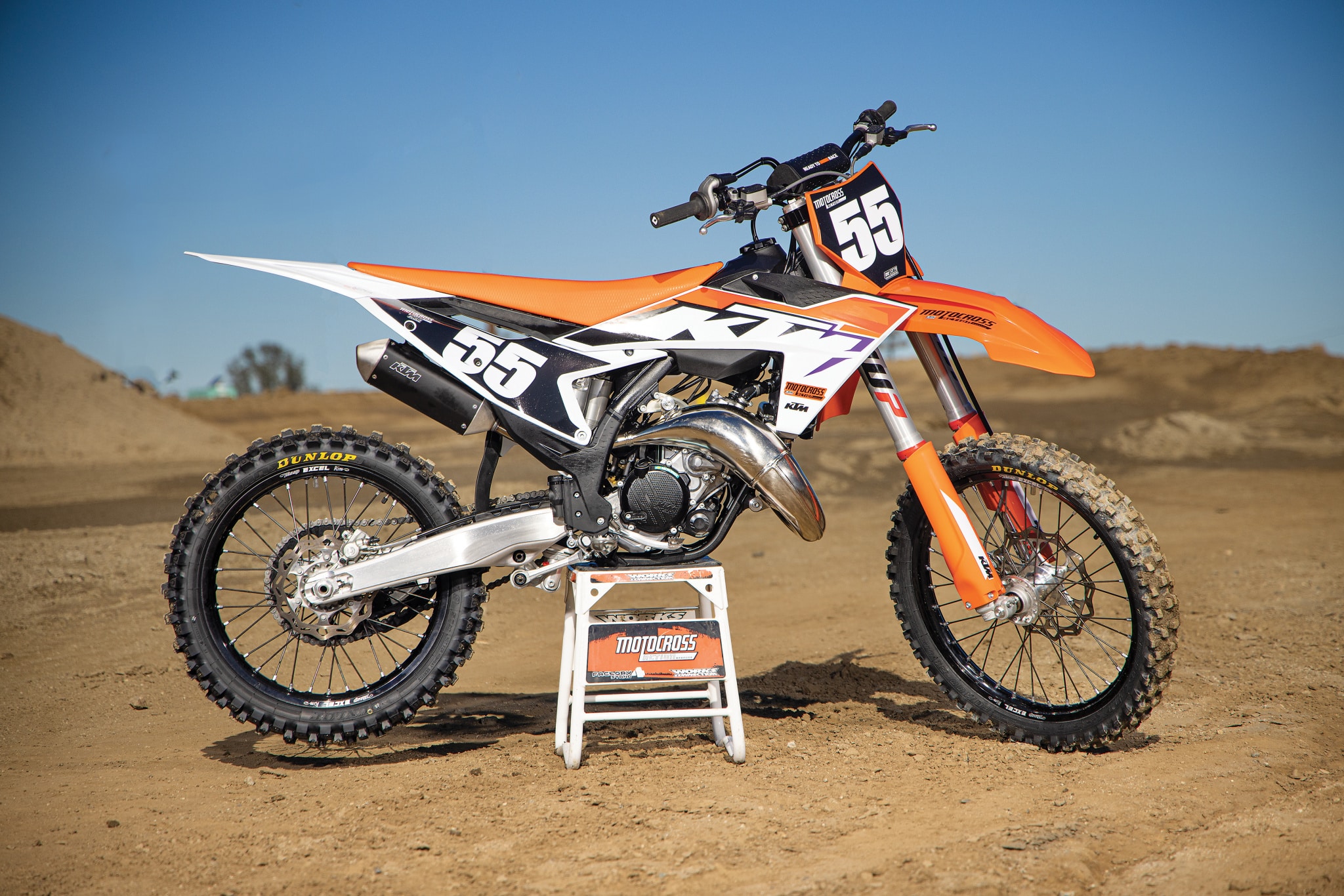
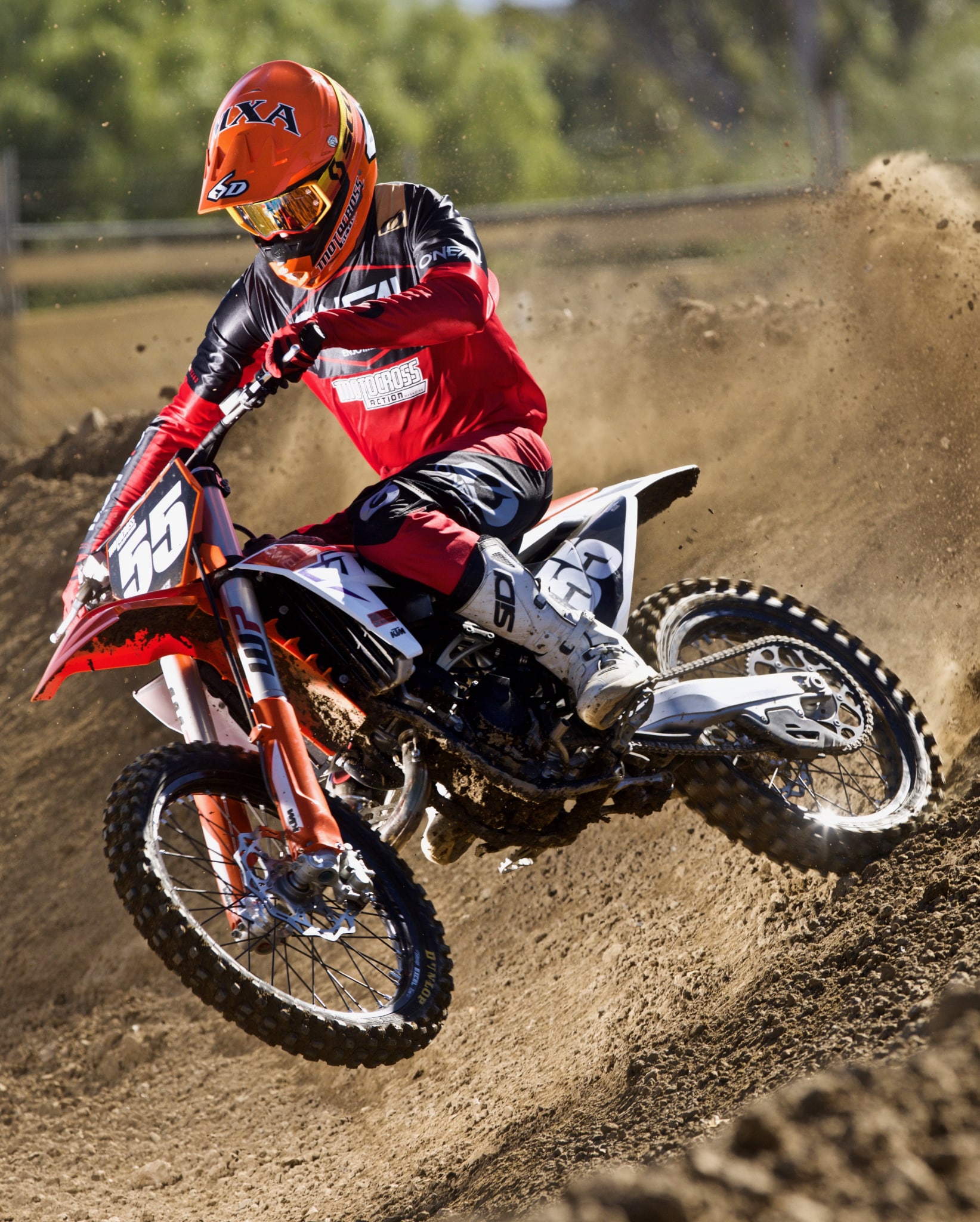
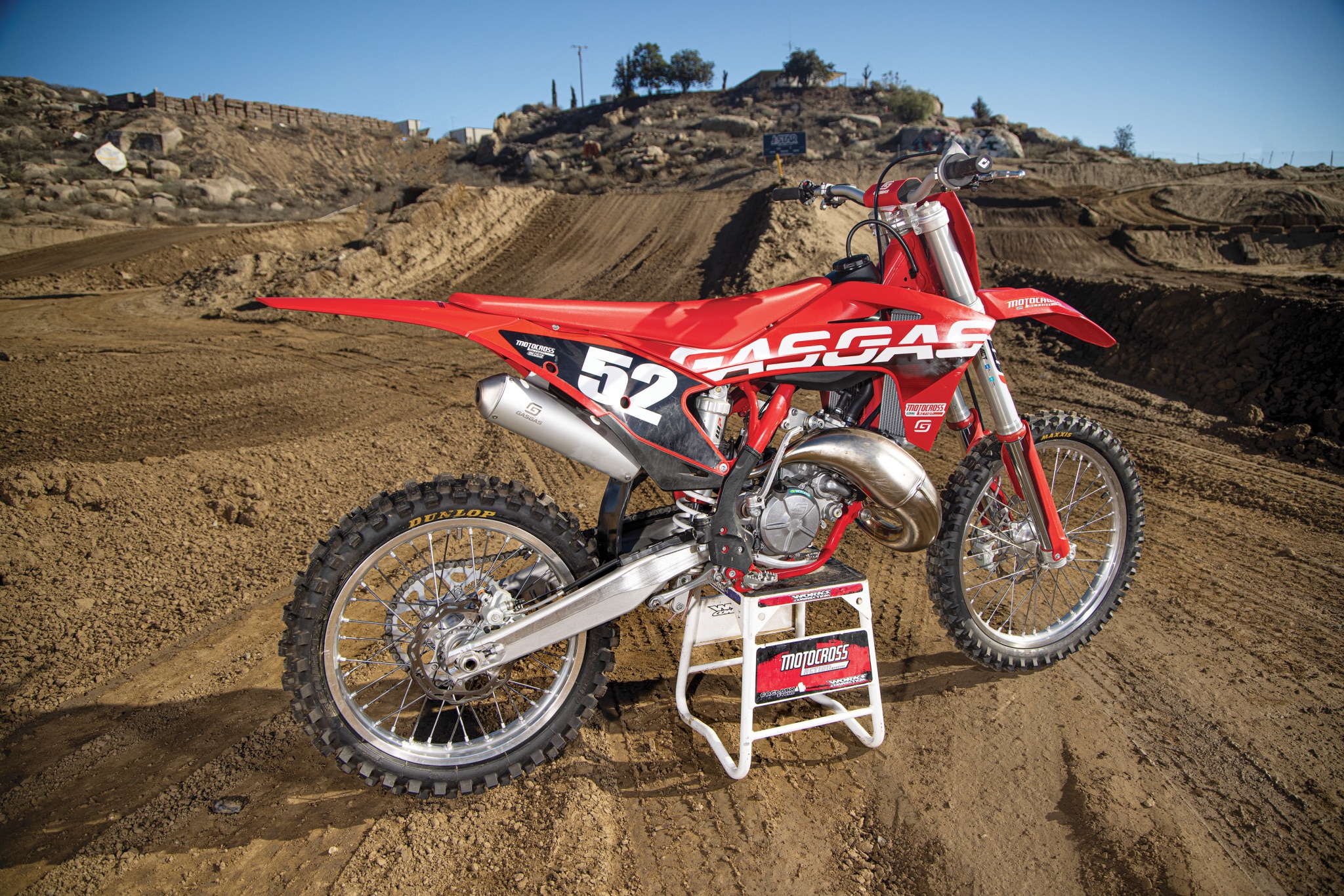
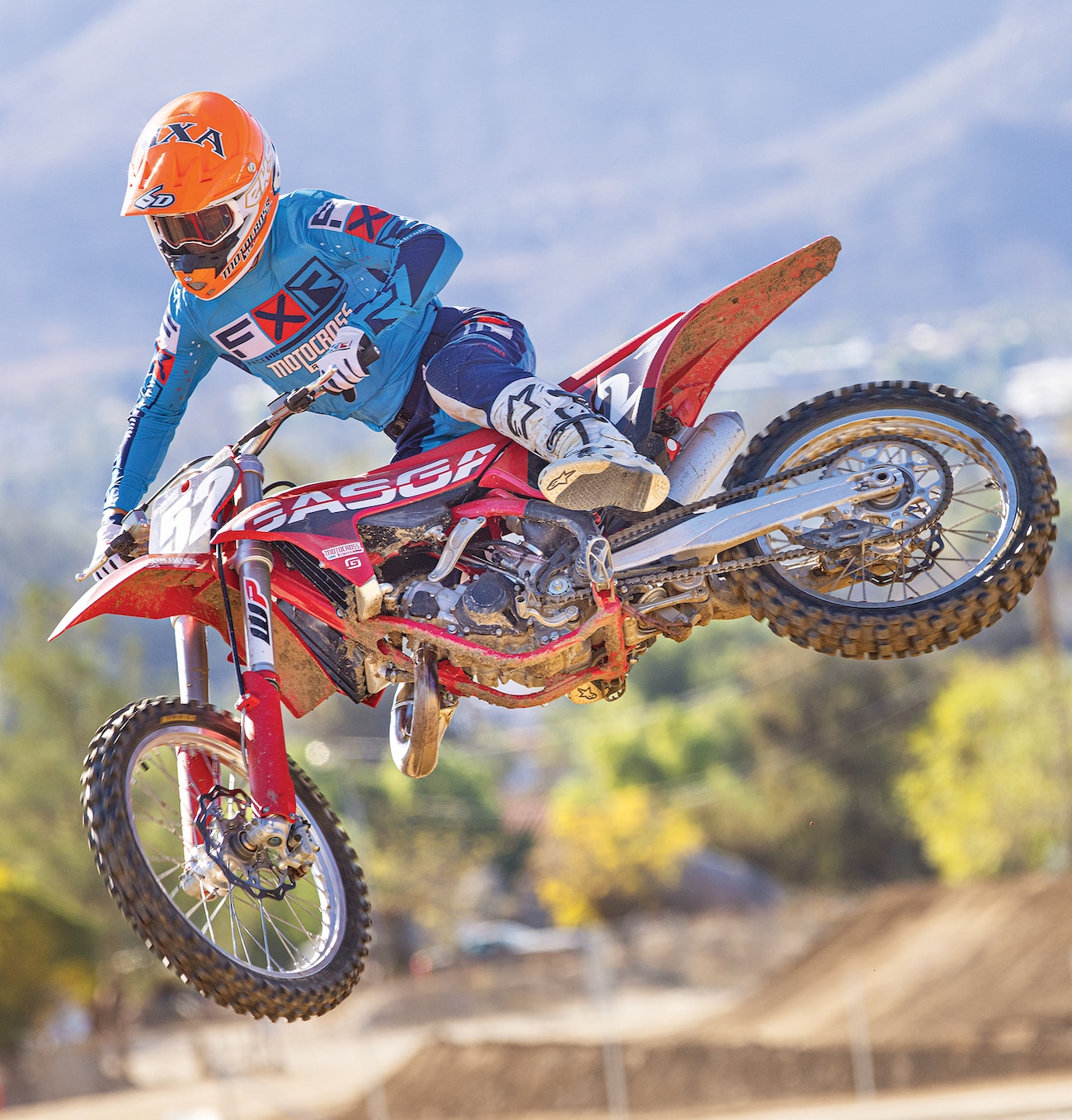

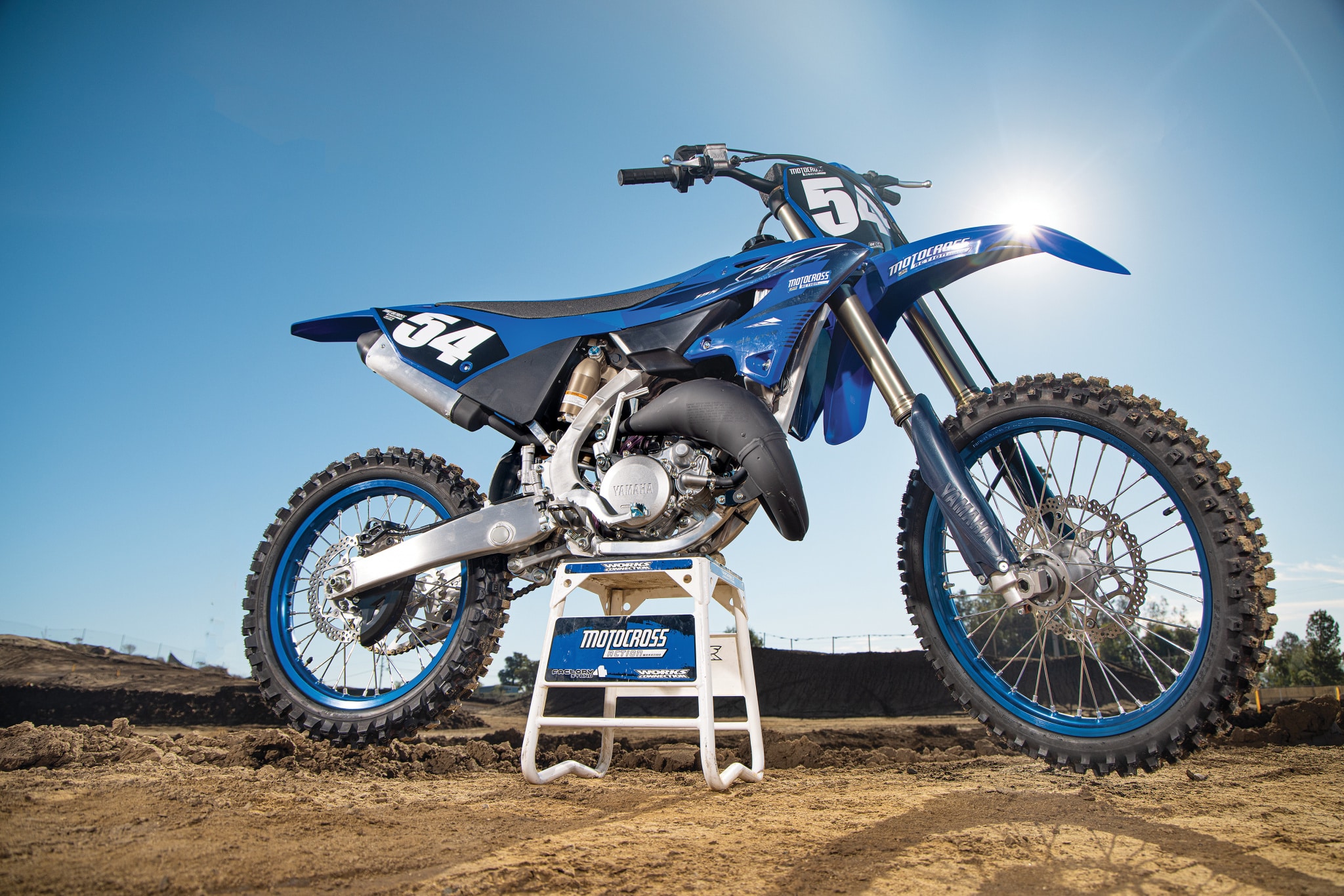
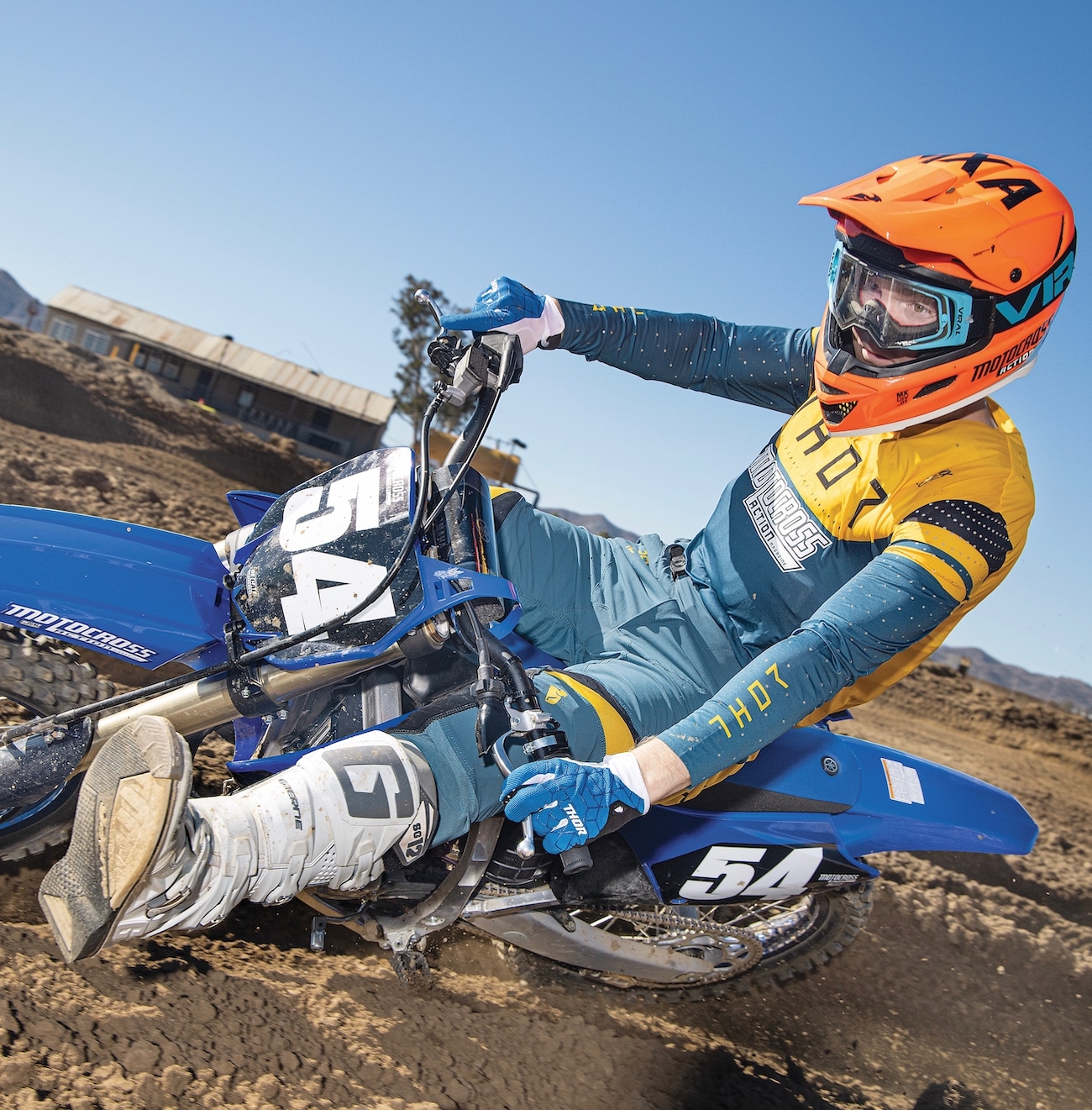
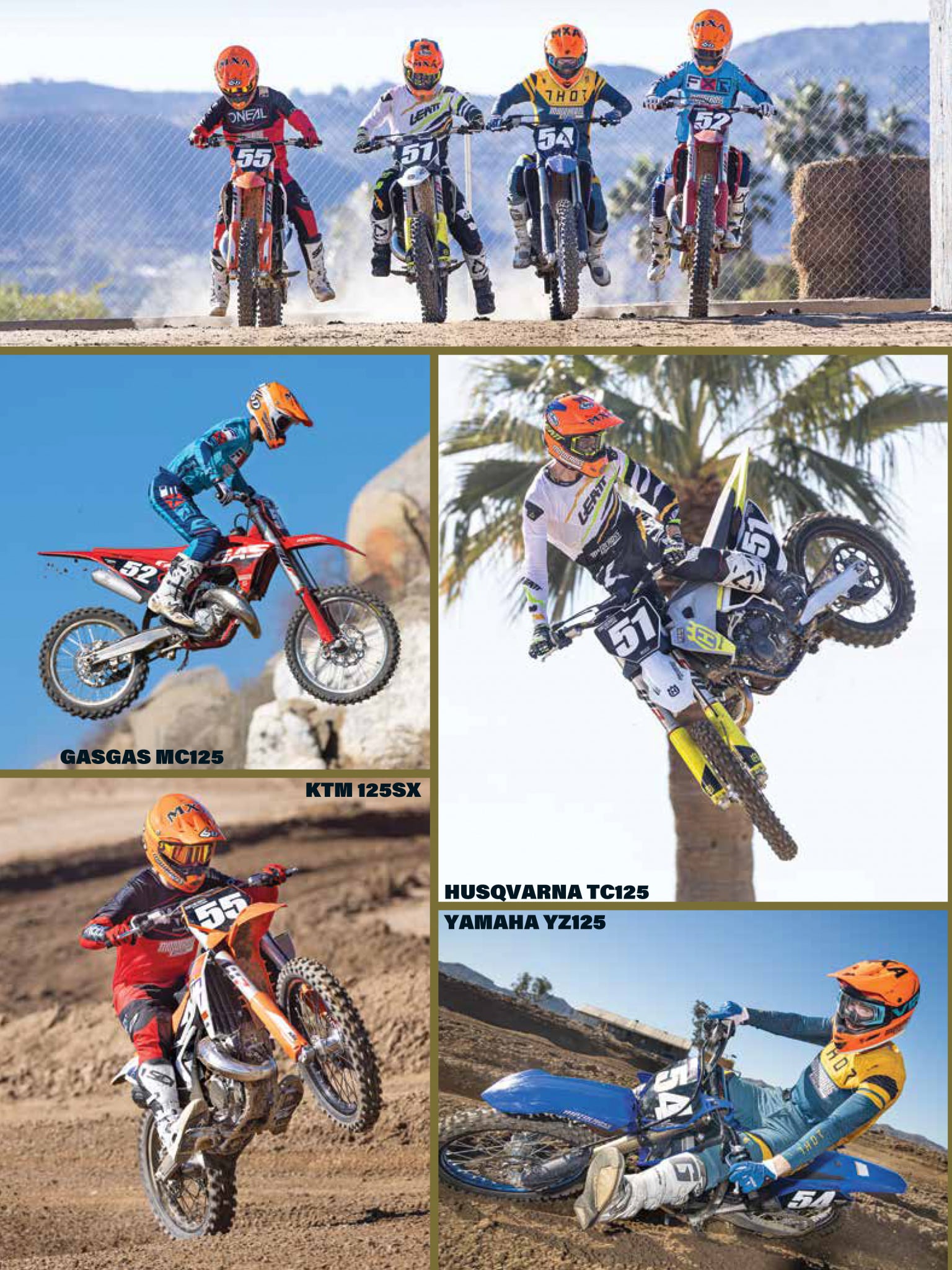
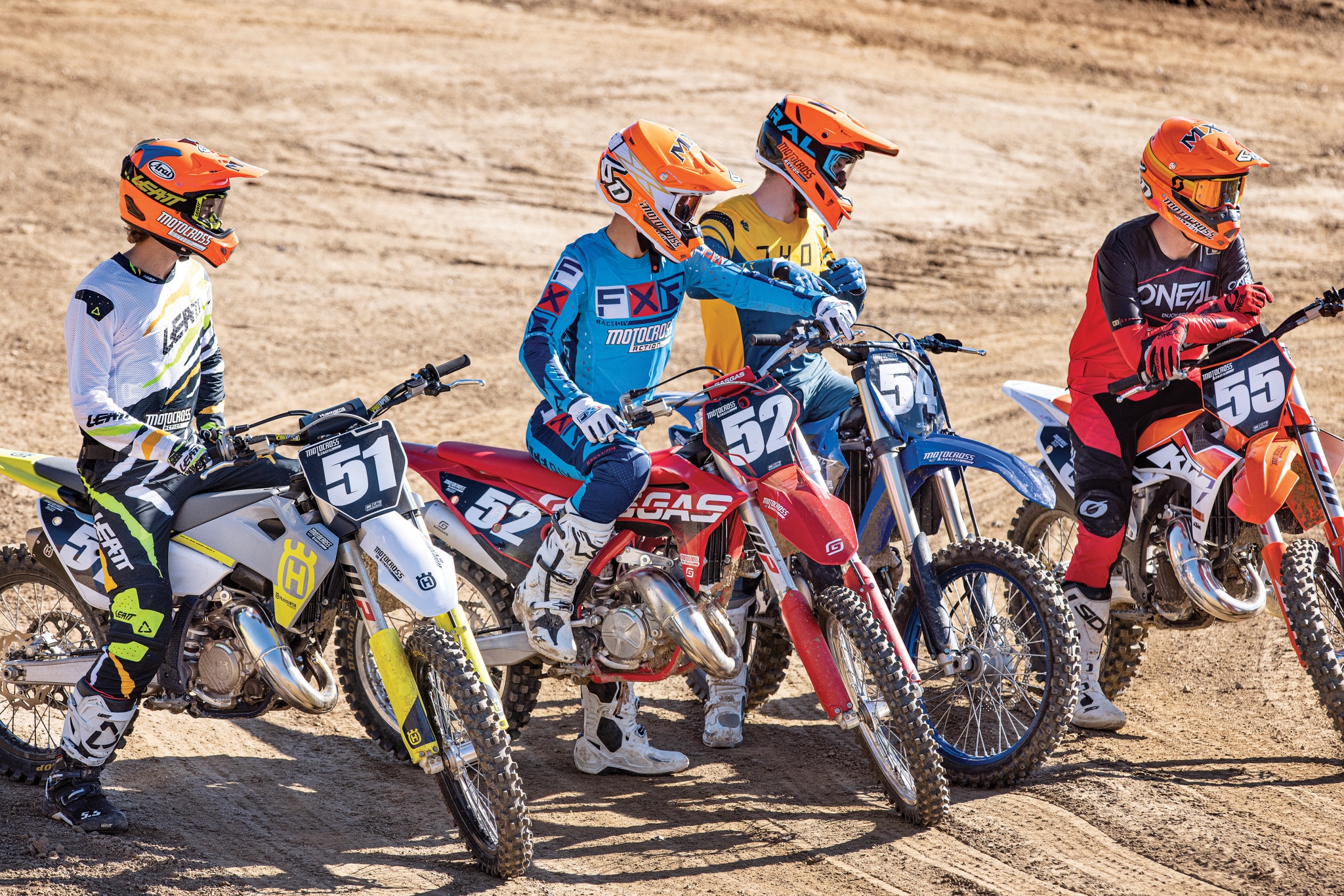
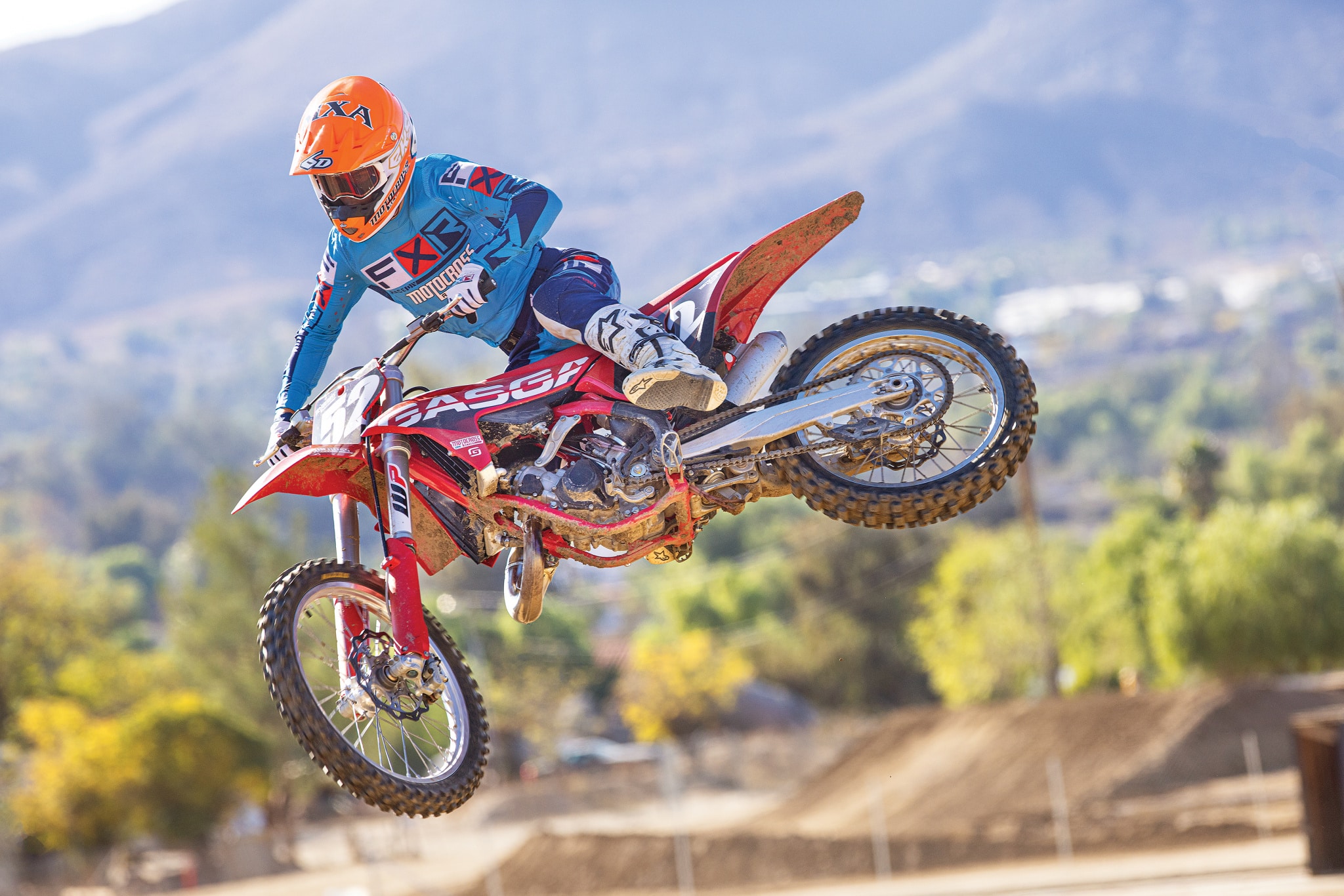
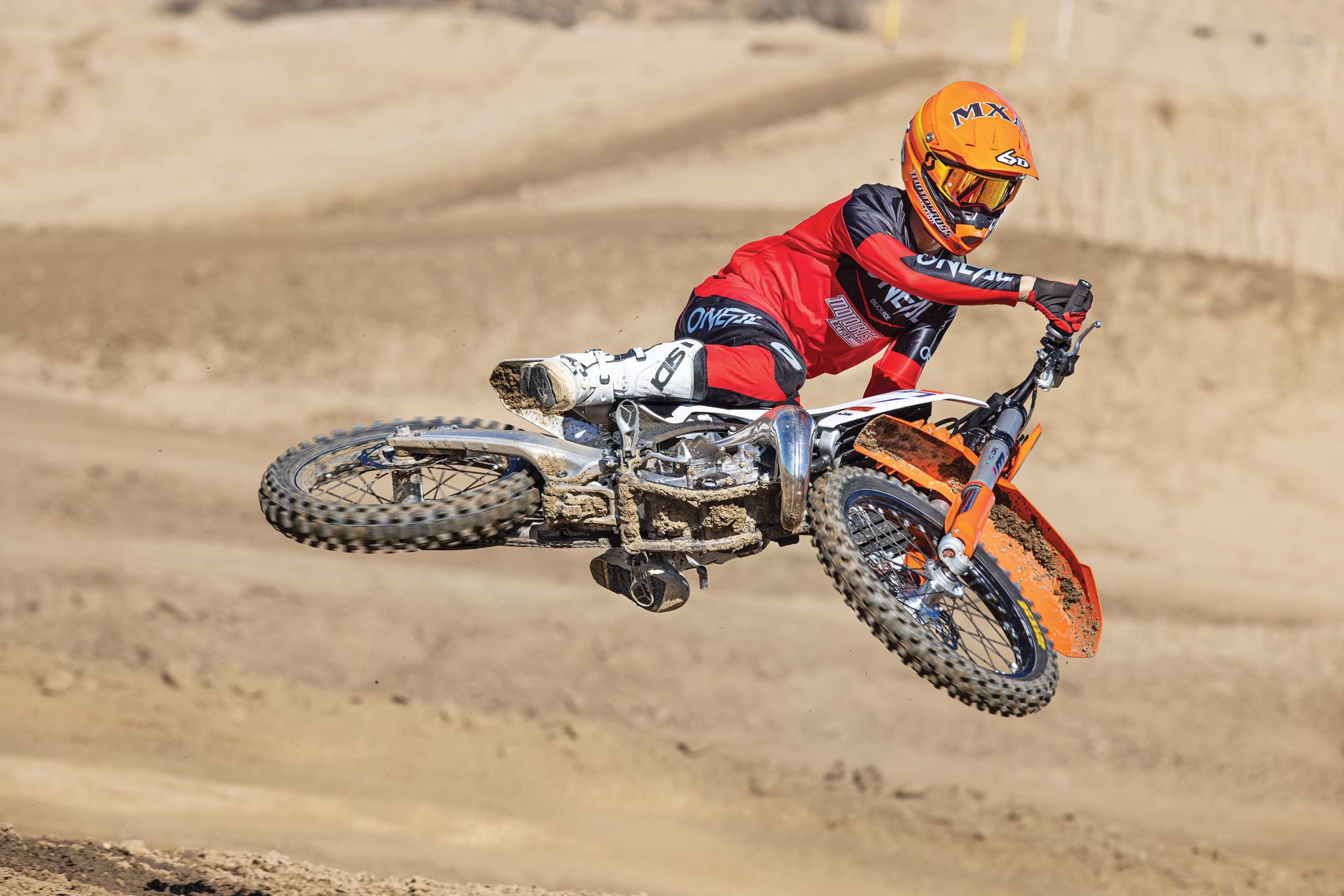
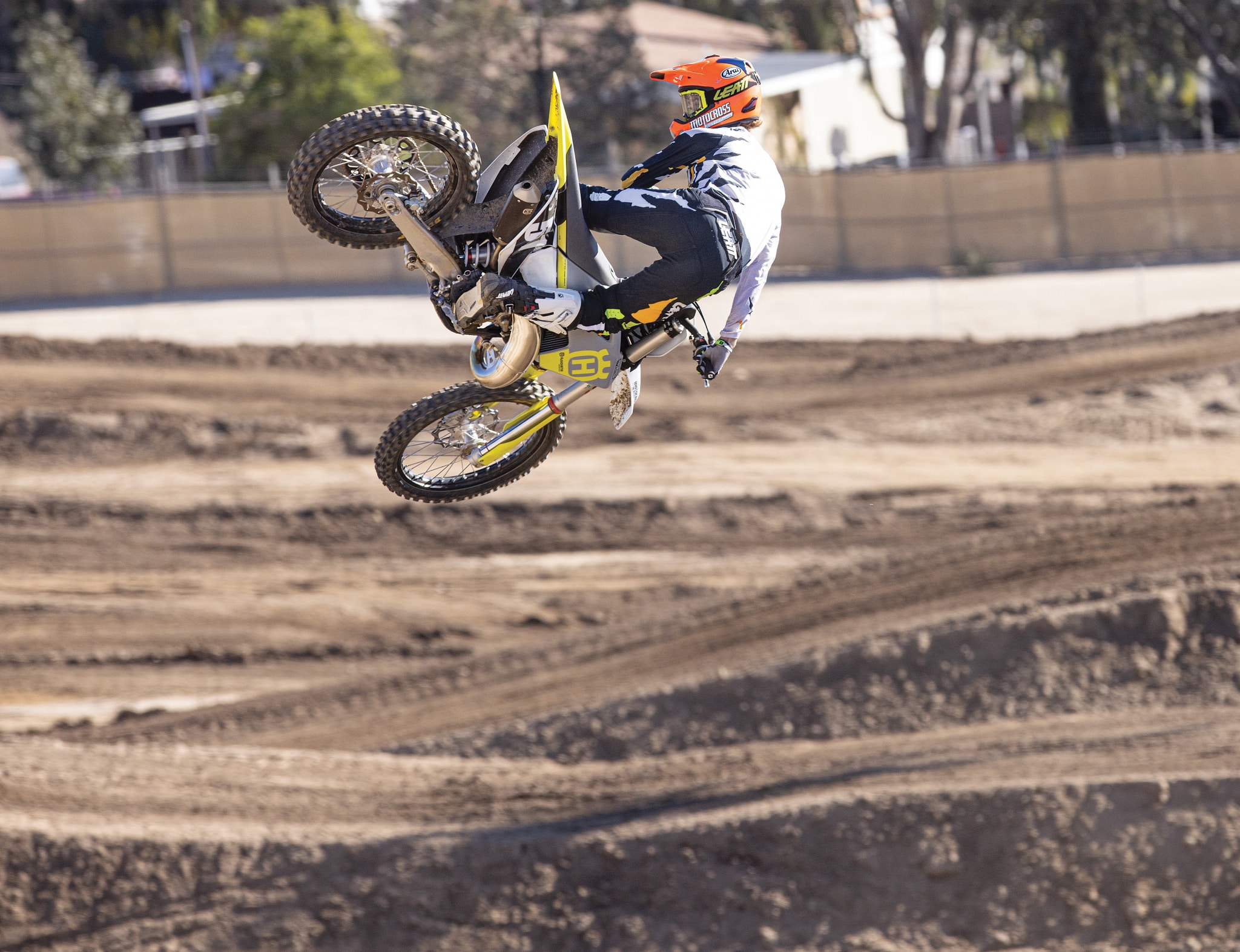
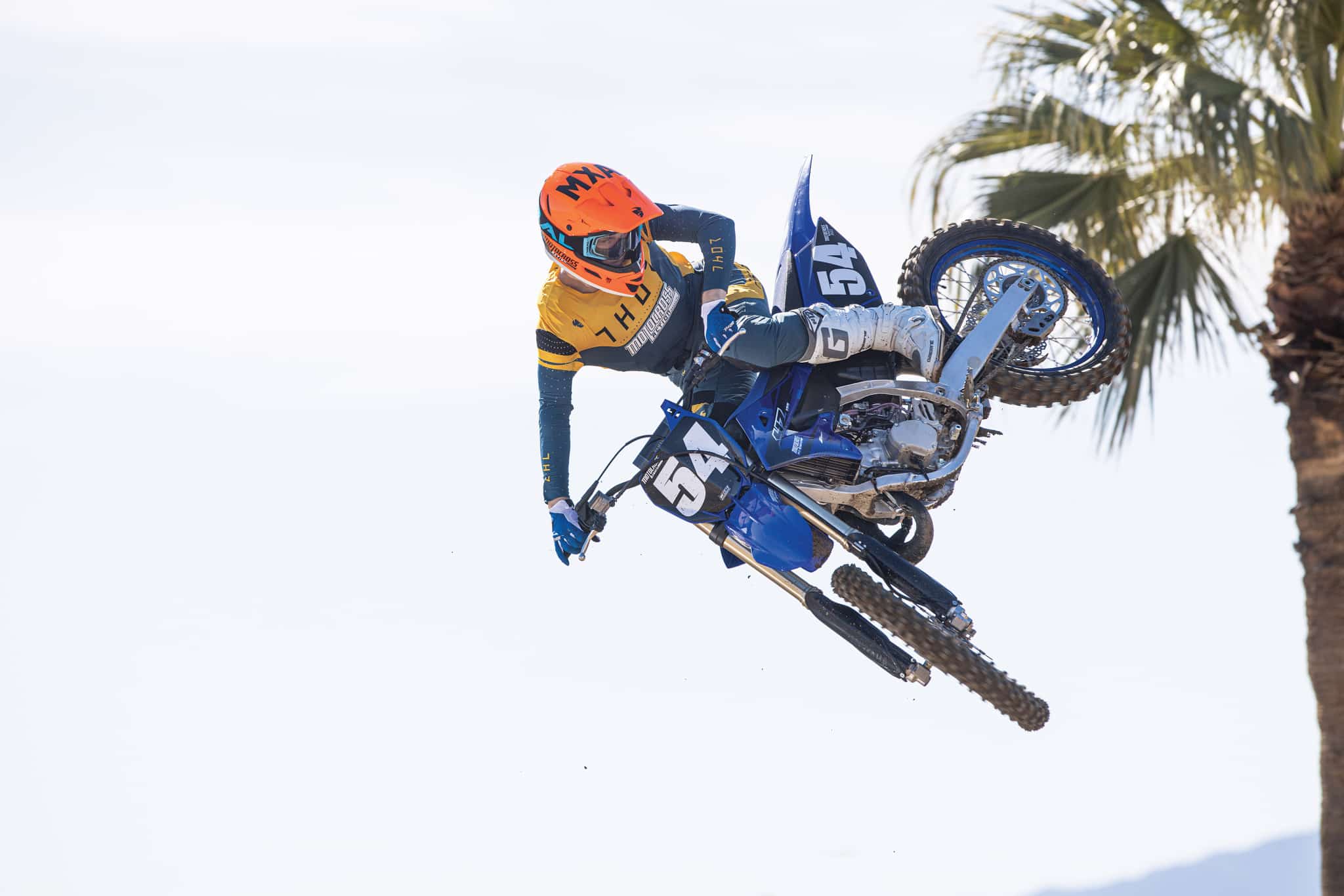




Comments are closed.